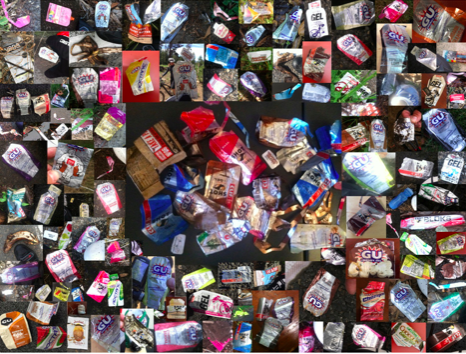Editor's Note: This opinion piece was written by Tal Johnson, the president and COO of GU Energy Labs.
I've noticed a correlation: the less healthy a product, the more it gets littered. Cigarette cartons? Fast food? Consumed and littered. Beer cans? Not inherently unhealthy, but when empties are tossed from moving cars, it's not healthy living.
There's a notable exception: energy food wrappers. Healthy products dropped by cyclists and runners engaged in healthy exercise.
So why do so many of us leave a trail of trash? Is it willful like a beer can from a car? Or honest accidents in which hands in jersey pockets pull out empty wrappers?
I hope it's more accident than intent. I suspect sometimes we think we dropped something, but we'd rather not screw up a Strava segment by turning around to pick it up. So we ride on.
Whatever the cause, the result sucks because beautiful places get sullied.
Out of some frustration, I started last summer to pick up wrappers I saw while riding. The picture shows my collection from rides around Portland, Berkeley, and other favorite spots. Recently I started logging the locations in Strava.
It was a ride on Emigration Canyon Road above Salt Lake City during Outdoor Retailer that most got under my skin. I picked up seven gel packets on a road remarkably un-littered with beer cans and cigarettes. But it was littered with energy food wrappers. Six were GU's.
The problem isn't one product, but most wrappers are gels. A lot of GU's in particular. There're also Clif gels (leashed and unleashed), some Hammer gels, Stinger gels, Clif and Kind bars, and banana peels.
A peel is far better than a wrapper, but it's litter. If you don't think so, drop one in front of your neighbor's house when they're outside and see the reaction you get. If you must drop a peel, drop it off the path. Better yet, pack it and compost at home.
I love moments when I round a corner and see beauty that exists only in nature, in certain places, and at certain times. What I hate is when it's spoiled by litter, whatever the source, but especially when what I do is the source.
At GU, we know we're part of a problem. And we don't like it, because it's not who we are. We want solutions that will keep trash – at least energy food trash - off our roads and trails.
Personally, my first move is to not litter. I use a top tube pack on my bike with a zippered side pocket. I only use the side for wrappers. It's accessible and visible, which means I generally don't drop things – and it's easy to see if I do.
Second, I stop and pick up other people's trash. Sometimes this means a lot of stops. I've stopped well over 100 times so far. That's a lot of Strava segments interrupted (alas, fewer KOM's).
I'll admit I don't stop 100 percent of the time. There are times I'm trying to PR a loop or am on a ride I don't want to interrupt. And there are days I know in advance I'm going to stop for every piece of energy food trash I see. Mostly, I stop.
My goal is to have no impact (by dropping nothing) or have a positive impact by picking up someone else's trash. To borrow a hockey metric, it's my plus/minus ratio. If all my rides have a positive plus/minus, I'm helping.
We're working at GU on a number of initiatives to help. To use less material in packaging, to keep it from being littered, to pick it up when it is, and to make it less impactful when all of the above still fail. Some are coming soon. Some need more time.
Ultimately, there's no difference between foil wrapper dropped by a cyclist and a beer can that's tossed out a car window – trash is trash.
I was +3 on my ride today. What's your plus/minus?
To learn more about what GU is doing to be one of the solutions, see terracycle.com.
Tal Johnson has been a director, president, and/or COO at Berkeley-based GU Energy since 2008. He was introduced to cycling thanks to GU and now logs at least 5,000 miles a year, including stops for trash.


